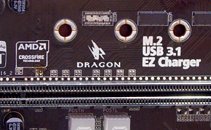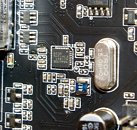Monday, July 6th 2015
Realtek Develops New Onboard LAN Chip to Win Back Gamer Crowd
In a bid to regain market share lost to Intel and Killer (Qualcomm) in the DIY motherboard market, particularly with motherboards targeted at online gaming PC builds; Realtek unveiled a new onboard LAN solution called the Realtek Dragon. Intel and Killer have replaced Realtek as a preferred onboard Ethernet chip provider for DIY PC motherboards over the past two generations, as perception of their lower driver overhead, lower latencies, and other advantages spread. Sensing that merely improving drivers for its existing RTL8111 family of PCIe gigabit Ethernet PHY chips won't fix the situation, Realtek sought to give its latest generation an off-beat brand name that it hopes could appeal to the DIY crowd.
At the heart of the Realtek Dragon is the new RTL8118AS, a PCIe gigabit Ethernet PHY, much like the 8111 family. Realtek says it made refinements to the chip over previous generations, which will offer better performance (lower driver overhead) for traffic with small UDP packets, which is how most online multiplayer games work, and lower power consumption than competing solutions, such as the Killer E2200. Realtek even set a new branding for its chip, and will allow motherboard makers to print it on their PCBs, just as they print branding for Killer or Intel onboard LAN solutions. Realtek Dragon will make its debut with certain socket LGA1151 motherboards by ECS.
Source:
Anandtech
At the heart of the Realtek Dragon is the new RTL8118AS, a PCIe gigabit Ethernet PHY, much like the 8111 family. Realtek says it made refinements to the chip over previous generations, which will offer better performance (lower driver overhead) for traffic with small UDP packets, which is how most online multiplayer games work, and lower power consumption than competing solutions, such as the Killer E2200. Realtek even set a new branding for its chip, and will allow motherboard makers to print it on their PCBs, just as they print branding for Killer or Intel onboard LAN solutions. Realtek Dragon will make its debut with certain socket LGA1151 motherboards by ECS.


43 Comments on Realtek Develops New Onboard LAN Chip to Win Back Gamer Crowd
communities.intel.com/thread/43498
...and intel has still not fixed it. FYI the threads are ~two years old!
I'm glad things are improving but the tiny incremental steps are not satisfactory in my opinion.
Today's Realtek has certainly improved a great deal from 10-15 years ago, enough to where I don't mind using one of their NICs if the rest of the board meets my needs. However when it comes down to it or another, they're probably going to lose out. Case in point: There were plenty of AM3 boards for me to choose from and I happen to get one with a pair of Broadcom NICs ;)
How about some affordable 10Gbe adapters? I would be more interested in that.
The NICs aren't the problem with >CAT6, it's the cable. CAT6 FTP is already considerably more than CAT5 and the price of CAT6 isn't going to come down much/any more. CAT8 will be prohibitively expensive (at least $0.50/foot).
I think what we need is a fiber push to consumers.
It looks like 10 GbE cards start well north of $100. 4-port unmanaged 10 GbE switches are $400'ish (figure $300 if it were embedded in a consumer router--just for the switch component). The price is coming down but not very fast.
I think that we already have a big problem in households and that problem is with voltage in outlets, a lot of devices have transformers and they transform it to below 24 V for most devices and in outlets the voltage is 110 V in USA and 230 V in Europe. And now we are also using LED and energy efficient bulbs which require a lot lower voltage and that means that a lot of the devices are using a lower voltage and we would not need so powerful transformers if there were outlets with voltage a lot lower.
Now with such lower voltage it would be easier to have fiber connection and more low voltage outlets for devices like switches or you can just get something like fiber/copper hybrid.
10 GbE could be used instead of load balancing with more than 1 GbE ports. For example you have a NAS with one 10 GbE port which is connected to a 10 GbE switch but clients are connected with only 1 GbE connection.